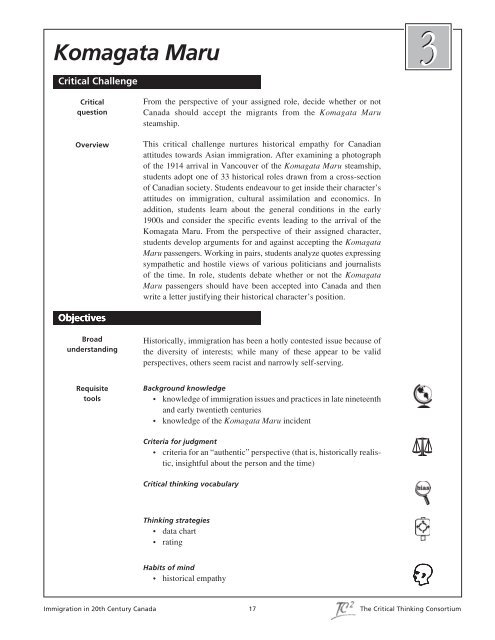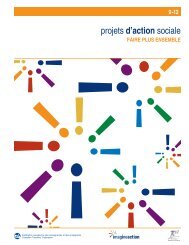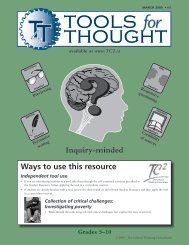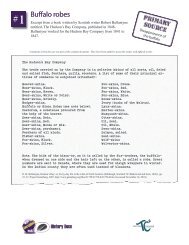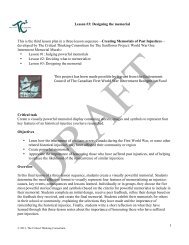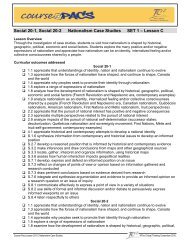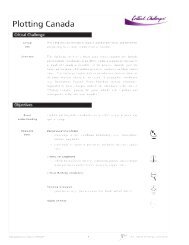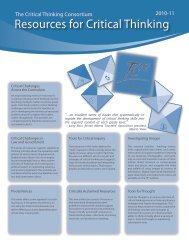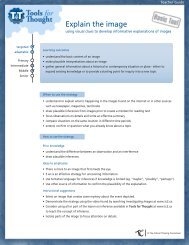Komagata Maru - The Critical Thinking Consortium
Komagata Maru - The Critical Thinking Consortium
Komagata Maru - The Critical Thinking Consortium
Create successful ePaper yourself
Turn your PDF publications into a flip-book with our unique Google optimized e-Paper software.
<strong>Komagata</strong> <strong>Maru</strong> 3<strong>Critical</strong> Challenge<strong>Critical</strong>questionOverviewFrom the perspective of your assigned role, decide whether or notCanada should accept the migrants from the <strong>Komagata</strong> <strong>Maru</strong>steamship.This critical challenge nurtures historical empathy for Canadianattitudes towards Asian immigration. After examining a photographof the 1914 arrival in Vancouver of the <strong>Komagata</strong> <strong>Maru</strong> steamship,students adopt one of 33 historical roles drawn from a cross-sectionof Canadian society. Students endeavour to get inside their character’sattitudes on immigration, cultural assimilation and economics. Inaddition, students learn about the general conditions in the early1900s and consider the specific events leading to the arrival of the<strong>Komagata</strong> <strong>Maru</strong>. From the perspective of their assigned character,students develop arguments for and against accepting the <strong>Komagata</strong><strong>Maru</strong> passengers. Working in pairs, students analyze quotes expressingsympathetic and hostile views of various politicians and journalistsof the time. In role, students debate whether or not the <strong>Komagata</strong><strong>Maru</strong> passengers should have been accepted into Canada and thenwrite a letter justifying their historical character’s position.ObjectivesBroadunderstandingHistorically, immigration has been a hotly contested issue because ofthe diversity of interests; while many of these appear to be validperspectives, others seem racist and narrowly self-serving.RequisitetoolsBackground knowledge• knowledge of immigration issues and practices in late nineteenthand early twentieth centuries• knowledge of the <strong>Komagata</strong> <strong>Maru</strong> incidentCriteria for judgment• criteria for an “authentic” perspective (that is, historically realistic,insightful about the person and the time)<strong>Critical</strong> thinking vocabulary<strong>Thinking</strong> strategies• data chart• ratingHabits of mind• historical empathyImmigration in 20th Century Canada 17 <strong>The</strong> <strong>Critical</strong> <strong>Thinking</strong> <strong>Consortium</strong>
Suggested ActivitiesSession OneBlackline Master #22Examine <strong>Komagata</strong><strong>Maru</strong> photographAssignhistorical roles➤➤Begin this challenge by displaying an overhead transparency of thephotograph <strong>Komagata</strong> <strong>Maru</strong> (Blackline Master #22). This photographis also available electronically at:http://www.lib.ucdavis.edu/punjab/s_komaphot.html#kphotos.) Ask studentsif they recognize the picture or understandits subject. Provide the followingcaption: “<strong>The</strong> <strong>Komagata</strong> <strong>Maru</strong> was asteamship from India. It arrived inVancouver’s harbour on May 23,1914.” Invite students to work witha partner for one minute to generateas many questions as they canabout the picture. Ask partners topair off with another group tocompare lists, cross off duplicatequestions and star the threemost thoughtful or interestingquestions. Randomly selectgroups to share their questions.Record these on theboard. Inform students thatthe answers to these questions willlikely be revealed as they explore the circumstancesand differing perspectives on this famous incident in Canadianimmigration history.Explain that each student is to adopt a rolerepresenting a cross-section of Canadian societyat the beginning of the 20 th century.Students are to assume this role as theyexamine the circumstances surrounding thearrival of the <strong>Komagata</strong> <strong>Maru</strong>. <strong>The</strong>y musttry to put aside their current personalopinions and attitudes regarding immigrationand try to adopt the view thatwas likely held by their assigned historicalcharacter. From a copy of Early20 th century roles (Blackline Master#23A-B), cut into slips of paper eachof the 32 roles (or however manyroles are needed; if additional rolesare required assign the same roleto more than one student). Randomlydistribute one slip to eachstudent.Immigration in 20th Century Canada 84 <strong>The</strong> <strong>Critical</strong> <strong>Thinking</strong> Cooperativeknowledge of theincidentName: ______________________________________________________ Blackline Master #22Sikhs aboard the <strong>Komagata</strong> <strong>Maru</strong>, 1914<strong>Komagata</strong> <strong>Maru</strong>(Vancouver Public Library, Special Collections, VPL 6231)http://www.lib.ucdavis.edu/punjab/s_komaphot.html#kphotosName: ______________________________________________________ Blackline Master #23AEarly 20th century rolesRole Personal data1. English businessman Protestant; strong monarchist/imperialist2. Scottish union organizer Vancouver marina worker3. Ukrainian farmer recent immigrant to Manitoba for free land4. Scandinavian forest worker seasonally employed on Vancouver Island5. Vancouver health nurse German ancestry; educated in Ontario6. Wilfrid Laurier, French ancestry; English educated;Prime Minister supports French and English settlement of the West7. Petty criminal involved in anti-Asian riots of 1907; English ancestry8. Anglican minister Christ Church Cathedral, Vancouver9. Sikh relative, one of approximately 5,000 mainly Sikh Indian immigrants living in BCwife of a farmer,10. Balwant Singh Kalsa Diwan Society; legal representative for the <strong>Komagata</strong> <strong>Maru</strong> passengers11. <strong>Komagata</strong> <strong>Maru</strong> passenger, one of 22 Sikhs allowed to land because he had previously been in Canadasawmill worker12. Japanese fisherman lives in Steveston; owns his own fishing boat13. Aboriginal leader Cree, northern Quebec, traditional trapper/hunter14. Aboriginal woman member of Musqueam band; lives on the Fraser River in south Vancouver15. Chinese herbal Chinatown business community leader; fluent in Mandarin and some Englishmedicine specialist16. Chinese maid one of a small number of Chinese women in BC17. Vancouver industrialist owner of False Creek heavy steel yards18. Quebec rural farmer French; Roman Catholic; prevented from moving west by Sifton’s school policy19. Quebec textile/ French-speaking woman; Roman Catholic; lives in Montrealdress shop owner20. Armand Lavergne, spokesperson against Sifton’s English-only school policy in the WestQuebec politicianImmigration in 20th Century Canada 85 <strong>The</strong> <strong>Critical</strong> <strong>Thinking</strong> CooperativeImmigration in 20th Century Canada 18 <strong>The</strong> <strong>Critical</strong> <strong>Thinking</strong> <strong>Consortium</strong>
Explain individualprofiles➤When students have been assigned their characters, display an overheadtransparency of Individual profile (Blackline Master #24). Explainthat students are to use the personal backgroundabout their assigned individual to imaginetheir character’s position on the fourissues listed in Blackline Master #24. Introduceeach of the scales and point out thatstudents need to provide two reasons tojustify each rating. It may be helpful towork through an example with the classto assist them in seeing how they mightdeduce their character’s attitudes. Possibleratings and rationale for a Britishcolonel’s views are suggested in BoerWar veteran profile (Blackline Master#25). Model the two-step processthat students might follow:• imagine the individual’s backgroundand experiences whichseem relevant to the issue underconsideration;• suggest a rating for each attitude.••••Immigration in 20th Century Canada 87 <strong>The</strong> <strong>Critical</strong> <strong>Thinking</strong> Cooperativehistorical empathyName: ______________________________________________________ Blackline Master #24Indicate on the scales your character’s attitude on each issue. Provide two supporting reasons for each rating.Individual profileMy role: ______________________________________________ Personal data: ________________________________________Loyalty to Canada 5 4 3 2 1strong nationalist strong anti-nationalist•Views on immigration •5 2 highly selective 4 3 1very welcomingName: ______________________________________________________ Blackline Master #25Boer War veteran profileMy role: ______________________________________________ Personal data: ________________________________________Loyalty to 4 Cultural perspective •2 11strong anti-nationaliststrong multiculturalistCanada 5 5 4strong nationalist3 single dominant culture 3 2 British Boer War veteran war colonel; strong British imperialist• he is likely a strong monarchist and British nationalist because he fought for Britain in the Boer War;• his ties to Canada may lie more with its membership in the British Empire than with any deep patriotism;on immigration 4 Views Economic orientation •5 2 capitalist 4highly selective 3 2 1strongly socialist1very welcomingstrongly 5 3 • if he is British and upper class, he would likely favour immigrants from the British Empire, includingthose from India;• fighting in South Africa during the Boer War may have created a low estimation of the worthiness ofnon-British people;Cultural perspective 5 4 3 2 1single dominant culture strong multiculturalistcultural traditions for the behaviours and values of English-Canadian society;• being a strong British imperialist suggests he would strongly favour immigrants abandoning their• possibly influenced by Rudyard Kipling he may hold the view that “British is better”;Complete individualprofiles➤Distribute a copy of Blackline Master#24 to each student. Remindstudents to place themselves in theminds and times of their assignedcharacter and imagine the issuesfrom that perspective. Explain thatthe objective is to encourage historicalempathy—the ability tosee things sensitively throughthe eyes of people who lived inearlier times. To help studentsdevelop a more informed perspective,distribute Immigrationin the early 1900s(Blackline Master #26A-B)to each student (or pair ofstudents). Direct studentsto read the briefingsheets and to use the informationto infer theircharacter’s attitude oneach issue and identifyreasons for eachrating.British Columbia was very much a frontier on the west ofthe continent, far removed from the more densely settledeastern provinces and the centre of national government inOttawa. Dramatic swings between strong economic growthand deep recession meant that workers would be in demandfor a while and then experience massive unemployment.<strong>The</strong> jobs of the early 1900s were often low-skilled work inmines, mills and canneries. Fewer skilled workers wererequired than are employed in the modern economy and,with the general lack of education and specialized skillsamong the workforce, workers were easily replaced by anyother worker who was willing do the job. <strong>The</strong> flood ofimmigrants provided a pool of labour but many wereexploited (i.e., hired to work the toughest jobs at the lowestwages) and endured working conditions that establishedCanadians would not tolerate. <strong>The</strong>re was no social safetynet-no minimum wage, paid vacations or limits on workinghours and age of employment. When people becameunemployed, they were often desperate until they found anew job.In keeping with a frontier economy, the great majority ofsettlers and immigrants were men. Men often precededwomen as immigrants because either theie work wastemporary and there was no point in uprooting their familiesor because the families would follow later after the menhad established a stable economic footing. Large numbersof men, far away and long separated from their families,often had a disruptive effect on the communities in whichthey resided. Given the harsh economic and personalconditions, it is easy to see why immigrant groups tendedto band together into ethnic communities such as Chinatownor industry-related ghettos. <strong>The</strong>se communities providedwhat was often the sole source of financial and culturalsupport and social contact for many immigrants.When Canada needed labour for large-scale projects suchas the railway, the door was opened to various immigrantgroups. Over three million immigrants came to Canadabetween 1891 and 1914, many drawn by job prospectsoffered by the building of the transcontinental railway,settlement of agricultural land in the Prairies and increasedindustrialization. <strong>The</strong> Canadian government actively5 strongly capitalist 4 3 1strongly socialist• as a colonel he may not have had much experience as a labourer or appreciate the value of unions;• because he is not an independent business owner he may not have strong capitalist ties, but mayappreciate the economic benefits that industry and business provide.Immigration in 20th Century Canada 88 <strong>The</strong> <strong>Critical</strong> <strong>Thinking</strong> CooperativeName: ______________________________________________________ Blackline Master #26Immigration in the early 1900srecruited immigrants because they were seen to be key toprosperity and growth. Instead of having categories ofimmigrants as Canada has today, immigrants were oftendealt with on the basis of country or nationality. Britishand American citizens were preferred over other ethnicgroups. However, the increased demand for labour resultedin significant numbers of other groups being activelyrecruited. For example, when Canada’s priority was tosettle the prairie grasslands, massive advertising was donein eastern and southern European countries whose peopleswere thought to be suitable for farming in this region.Increasingly in the 20th century, larger numbers ofimmigrants arrived from Asia (Japan, India and China) andnon-English speaking parts of Europe.Newcomers to Canada were not consistently welcomed.Some residents, who may have themselves immigrated orcome from immigrant families, feared the loss of their jobsto people who would work for much lower wages. On theother hand, business leaders with large-scale projects oftensaw immigrant labourers as an easy way to cut costs, sincethey were able to employ them at considerably less-as littleas one-half the salary paid to workers already establishedin Canada. For others, recruiting immigrants who wouldbecome assimilated into the “Canadian” way of life wasmore important than building the labour force. Many peopleof British descent wanted immigrants to adopt the behaviourand values of English-Canadian society and to relinquishthe cultural traditions they brought from their homecountries. Aboriginal people saw immigrants as a seriousthreat to their traditional way of life. For many aboriginalcommunities, immigration meant the loss of land andresource opportunities, the introduction of diseases and aswelling “foreign” population. Others residents of Canadawelcomed ethnic differences and saw Canada as a culturalmosaic or patchwork where the social landscape wouldreflect a variety of immigrant cultures, each an importantpart of Canadian society. French-Canadian nationalists,for example, valued their distinct language, religion andlegal system and saw broadly-based immigration as a wayto reduce Canada’s conformity to British traditions andpractices.knowledge ofhistory ofimmigrationImmigration in 20th Century Canada 89 <strong>The</strong> <strong>Critical</strong> <strong>Thinking</strong> Cooperativefamiliarity withcontext of timeImmigration in 20th Century Canada 19 <strong>The</strong> <strong>Critical</strong> <strong>Thinking</strong> <strong>Consortium</strong>
“white” province.Session TwoBlackline Masters #27-28Recordinitial reasonsDevelop backgroundknowledge➤➤Once the character profiles are complete, invite students to exploretheir character’s views on accepting the <strong>Komagata</strong> <strong>Maru</strong> passengersas immigrants to Canada. Ask students to record on a sheet of paperdivided into two columns all plausible reasons why their characterwould and would not allow the ship’s passengers into Canada. Encouragestudents to look for the conflicting tensions that might arisefor their character. For example, labourers may worry that Asianimmigrants would take away their jobs; on the other hand, as fellowworkers, they might be sympathetic to the immigrants’ need to supporttheir families. Inform students that they will have opportunities torecord additional arguments as they learn more about the <strong>Komagata</strong><strong>Maru</strong> incident. As a class, you may wish to briefly discuss the reasonsthat students generated.Provide students with additional information about the <strong>Komagata</strong><strong>Maru</strong> incident by distributing a copy of Immigrants from India(Blackline Master #27A-B) to each student or pair of students. Thisbriefing sheet does not reveal the eventual outcome of the incident soas not to influence students’ thinking. After reading the sheet, studentsare to list on their “reasons” sheet additional pro and con argumentsfor accepting the ship’s passengers as immigrants. Again, you maywish to invite students to share their positions as a class, with a partneror in small groups.Name: ______________________________________________________ Blackline Master #27A<strong>The</strong> first reported immigrants from India arrived in BritishColumbia in 1904. By 1908, the number had grown toImmigrants from Indiaalmost 5,000. Most were Sikhs from the Punjab in northernIndia, but Parsees, Hindus and Muslims also came. Manysingle men left India to find work so they could improvetheir economic situation and then return to India to supporttheir families. Despite the fact that these immigrants werenot adapt to the “Canadian” way of life, would take theirjobs and become so successful at business that they wouldmembers of the British Empire and all had Britishcitizenship, they were met with hostility upon their arrivalin British Columbia from citizens who were mainly ofcontrol the economy. This reinforced the prejudice of manyBritish Columbians who pressured the local government tostop the “brown invasion” in what they claimed was aBritish and American descent. Many worried thatimmigrants from India (and other Asian countries) wouldIn 1907, a bill was passed prohibiting Asians from voting,running for public office, serving on juries or becomingaccountants, lawyers or pharmacists. A year later, the BritishColumbia government asked Ottawa to decrease the flowof new Asian immigrants. In response, the Lauriergovernment passed an Order in Councilrequiring that (1) all Asian immigrantspossess $200 in cash at the time of arrivaland (2) passenger ships from the Far Eastmust make a “continuous passage” (thatis, sail directly to Canada on a throughticket purchased in the country of origin).Three shipping lines operated from theEast at the time, and none of themoriginated at an Indian port or offereddirect steamship service to Canada.Without any direct travel connectionsbetween the two countries, the lawprevented any immigration from India andJapan. <strong>The</strong> barriers to Asian immigrationwent unchallenged until 1914 when GurditSingh, a wealthy Sikh merchant andcontractor from Hong Kong, chartered aship to bring prospective immigrants fromIndia to Vancouver.Singh chartered a Japanese vessel the<strong>Komagata</strong> <strong>Maru</strong> through a German agentand picked up 376 passengers (340 Sikhs,12 Hindus and 24 Muslims) in HongHINDO BRITISH SUBJECT,—Alas, I must be mistaken! I thought theKong, Shanghai and Yokohama. Ticketssold for $210. <strong>The</strong> ship was outfitted withword “British” meant Freedom and Liberty!533 wooden benches for sleeping andsitting, latrines, a portable coal stove, adoctor and a granthi (priest). In additionto its passengers, the ship carried 1500<strong>The</strong> Montreal Daily Star, March 28, 1908. Cartoon taken from Charles and Cythia Hou (1997).Great Canadian Political Cartoons: 1820-1914 (Vancouver: Moody’s Lookout Press, p. 156).Immigration in 20th Century Canada 90 <strong>The</strong> <strong>Critical</strong> <strong>Thinking</strong> Cooperativetonnes of coal. A German cable companywired a message announcing the departureof the steamship from Shanghai with “400Indians on board.” <strong>The</strong> British presspicked up the news and the Vancouvernewspaper <strong>The</strong> Province published anImmigration in 20th Century Canada 20 <strong>The</strong> <strong>Critical</strong> <strong>Thinking</strong> <strong>Consortium</strong>
Record additionalreasonsRecordadditonal reasons➤➤As one final source of arguments for and againstAsian immigration in the early 1900s, studentsare to analyze comments made at the time bypoliticians, public figures and journalists. Sixquotes are found on Historical perspectives(Blackline Master #28A-C). You may wantto create overheard transparencies of threesheets for the entire class to read. Alternatively,duplicate approximately five copiesof each sheet and distribute one sheetto each pair of students. When each pairhas analyzed its sheet, circulate thesheets in two rotations until all pairshave examined all three sheets. Directstudents to read the quotes onBlackline Master #28A-C and recordtheir analysis on Analyzing perspectives(Blackline Master #29). Pointout that students are to indicate the numberof the quote and the name of the person making thestatement. Students are to identify the author’s position on Asianimmigration and summarize the arguments presented. When partnershave analyzed the quotes, they are to decide, according to their owncharacter’s perspective, the extent to which their character wouldagree or disagree with the arguments and provide a reason(s) for theassigned rating. To record their analyses of the six quotes, everystudent will need three copies of Blackline Masters #29. If you anticipatethat students will have difficulty with this task, complete theanalysis of the first quote as a class.When students have recorded their analyses of the quotes on BlacklineMaster #29, invite them to add on their “reasons” sheet any newarguments for and against accepting the <strong>Komagata</strong> <strong>Maru</strong> passengers.Name: ______________________________________________________ Blackline Master #28A1 “Four thousand odd have come and come to stay. <strong>The</strong>y wisely left their wives and childrenbehind till they had a home for them, but when ready to bring them in they find a new law inforce which says these must come in by ‘continuous voyage.’ <strong>The</strong> passing from one steamerto another at Hong Kong is interpreted by Mr. McGill, immigration agent in British Columbia,as breaking voyage and enough to keep them out. . . . Still further, remember that it wasthe Sikhs, at the most critical period of the Indian Mutiny, that saved the situation, and whofrom that day to this, in many a well-fought field, have proved what brave, loyal soldiersthey can be. If they are worthy to fight our battles for the glory of the Empire, are they notworthy to share in its advantages?”Reverend Dr. Wilkie in the Toronto Globe.Reprinted in <strong>The</strong> Aryan, [Sikh community newspaper], Victoria, February 1912.Historical perspectives2 “It was clearly recognized in regard to emigration from India to Canada that the native ofIndia is not a person suited to this country, that, accustomed as many of them are to theconditions of a tropical climate, and possessing manners and customs so unlike those of ourown people, their inability to readily adapt themselves to surroundings entirely differentcould not do other than entail an amount of privation and suffering which rend a discontinuanceof such immigration most desirable in the interests of the Indians themselves.”W.L. Mackenzie King, then Minister of Labour, Immigration to CanadaFrom the Orient and Immigration from India in Particular, Ottawa, May 2, 1908.3 “If Canadians were to completely isolate themselves from Hindustances and Asiatics ingeneral, as Messrs. Borden, Laurier & Co, and partners propose to do, by building a greaterwall than ever the Chinese built in their country in the dark ages, they must, by the violationof social laws, as miserably stagnate, in course of time, as the Zulus, Chinese, andHindustances did before the advent of modern times. . . . Natural resources are here inabundance, but the capital and labour are shy. Considering that under the capitalist systemof production internationalism is unavoidable, Canada must welcome Asiatic capital andlabour within certain limits, if this province would ever have an economically sound production.”<strong>The</strong> Hindustance, Vancouver, April 1, 1914.Immigration in 20th Century Canada 92 <strong>The</strong> <strong>Critical</strong> <strong>Thinking</strong> CooperativeSession ThreePosecritical question➤Having assembled a range of relevant arguments, students are now topropose their historical character’s position on whether or not toaccept the passengers of the <strong>Komagata</strong> <strong>Maru</strong>. Introduce the criticaltask:From the perspective of your assigned role, decide whether ornot Canada should accept the migrants from the <strong>Komagata</strong><strong>Maru</strong> steamship.Explain that students will first debate the issue as a class and thenwrite out their final position and justification. Before students begintheir deliberations, introduce the criteria for an “empathic” decision.Encourage students to consider two criteria when reaching their decisionand developing their reasons:• is historically realistic given the times;• represents a thoughtful understanding of the character (i.e., presentsthe character’s perspective sensitively and intelligently).criteria for“authentic”perspectiveImmigration in 20th Century Canada 21 <strong>The</strong> <strong>Critical</strong> <strong>Thinking</strong> <strong>Consortium</strong>
Debatethe issue➤Invite students to organize their chairs in a large “U” shape (or simplyto sit on the floor in this shape). Students whose characters arestrongly opposed to accepting the immigrants should locate themselvesat one tip of the “U”; those whose characters strongly supportacceptance of the immigrants should locate themselves at the other tip.Students whose characters have more mixed opinions should locatethemselves along the continuum in a position representing their relativeinclination for one side or the other. Those students who are tornon the question and cannot decide should likely locate themselves inthe middle of the “U”. In role, students are to introduce themselvesand present their character’s arguments, ensuring that they thoughtfullyportray their character. Encourage students to present their characterin an intelligent and sympathetic light. Although students’ argumentsmust be consistent with their character and historically realistic,the goal is to try to make their characters seem as sensible andreasonable as possible. Periodically during the discussion, invite anystudents whose character might be persuaded by arguments expressedto move along the continuum to a more appropriate location. At somepoint in the discussion, you may also want to ask students in the verymiddle to choose a side and explain what arguments inclined them oneway or the other.U-shaped debateJustify theirfinal position➤Assign students to write a letter in role to a friend who has just heard ofthe <strong>Komagata</strong> <strong>Maru</strong> incident and wants to know the historical character’sview on what should have been done with the passengers. Encouragestudents to refer to the arguments and evidence they havegathered in their individual research, group activities and U-shapeddebate in preparing their position and justification. Remind studentsthat their decision and justification must be historically realistic andthoughtfully represent their character’s perspective. Explain that theletter should contain the following• the character’s position on the issue;• reasons for the decision;• reasons why the character might be drawn to the other option.Debriefthe outcome➤Provide students with the following facts about the outcome of the<strong>Komagata</strong> <strong>Maru</strong> incident:• after two months of legal battle with the Canadian government, theimmigration appeal filed on behalf of the passengers by the Sikhcommunity was rejected on the grounds that their immigration wasillegal (the passengers did not have the $200 per person that wasrequired to enter BC and the ship had not arrived via direct passagefrom India);• only 24 passengers, who claimed to be Canadian residents, weregiven permission to stay;• the <strong>Komagata</strong> <strong>Maru</strong> and its passengers were forced to leave Vancouverharbour on July 23, 1914 and return to Hong Kong;• World War I broke out in August 1914, while the ship was en routeto India.• Sikhs in Vancouver resented the government’s handling of the<strong>Komagata</strong> <strong>Maru</strong> incident and retaliated by attacking police spiesand shooting several people. Mewa Singh, a member of the SikhImmigration in 20th Century Canada 22 <strong>The</strong> <strong>Critical</strong> <strong>Thinking</strong> <strong>Consortium</strong>
community, was convicted and executed for killing an immigrationofficial.EvaluationBlackline Masters #30-32Assessthe rating➤Assess each student’s ratings of their characterand rationale recorded on Individual profile(Blackline Master #24) using the rubricAssessing the rating (Blackline Master #30).According to this rubric, the assignment isworth 10 marks and is assessed on twocriteria:• plausible ratings,• thoughtful reasons.Name: ______________________________________________________ Blackline Master #30Use the following rubric to assess students’ ratings and justification of their character’s position on the four issues. Awardintermediate marks for evidence falling between the descriptors.Underdeveloped Competent Well DevelopedPlausible None of the ratings seem Two of the ratings seem All four ratings seem veryratings plausible, given the character’s plausible, given the character’s plausible, given the character’sbackground. background. background.1 3 5Thoughtful Provides no thoughtful reasons Provides one thoughtful reason Provides two very thoughtfulreasons to support the assigned ratings. for each rating. reasons for each of the fourratings.1 3 5Comments:Assessing the ratingTOTAL / 10Assess theperspective➤Assess students’ analysis of quotes onAnalyzing perspectives (BlacklineMasters #29) using the rubric Assessingthe perspectives (BlacklineMaster #31). According to this rubric,the assignment is worth 10marks and is assessed on two criteria:• accurate and complete summaryof authors’ positions andreasons,• plausible ratings.Name: ______________________________________________________ Blackline Master #31Use the following rubric to assess students’ analyses of the six historical quotes. Award intermediate marks for evidencefalling between the descriptors.Assessing the perspectivesUnderdeveloped Competent Well DevelopedAccurate and None of the ratings seem Two of the ratings seem All four ratings seem verycomplete plausible, given the character’s plausible, given the character’s plausible, given the character’ssummary background. background. background.1 3 5Plausible None of the ratings seem Three of the ratings seem All of the ratings seem veryratings plausible, given the plausible, given the plausible, given theexplanation and the explanation and the explanation and thecharacter’s background. character’s background. character’s background.1 3 5Comments:TOTAL / 10Name: ______________________________________________________ Blackline Master #32Use the following rubric to assess the students’ justification of their character’s position on the <strong>Komagata</strong> <strong>Maru</strong>. Awardintermediate marks for evidence falling between the descriptors.Underdeveloped Competent Well DevelopedReasons for <strong>The</strong> reasons for the chosen <strong>The</strong> reasons for the chosen <strong>The</strong> reasons for the chosendecision position are historically position are generally realistic position are very realistic andunrealistic and show no and show some understanding thoughtfully represent theunderstanding of the of the character’s perspective. character’s perspective.character’s perspective.1 3 5Reasons for Provides no reasons to support Provides reasons to support the Provides reasons to support thehistorically realistic and generally realistic and show realistic and thoughtfullyAssessing the justificationImmigration in 20th Century Canada 95 <strong>The</strong> <strong>Critical</strong> <strong>Thinking</strong> CooperativeComments:sensitive to the character’s some understanding of the represent the character’sperspective. character’s perspective. perspective.other position the other position that are other position that are other position that are veryAssess thearguments➤Assess each student’s identificationof pro and con argumentson the <strong>Komagata</strong> <strong>Maru</strong> byawarding one mark for each plausiblereason up to a maximum of fivemarks for the pros and five marksfor the cons.1 3 5Immigration in 20th Century Canada 96 <strong>The</strong> <strong>Critical</strong> <strong>Thinking</strong> CooperativeTOTAL / 10Assess thejustification➤Assess students’ letter justifyingtheir character’s position onthe <strong>Komagata</strong> <strong>Maru</strong> passengersusing the rubric Assessing the justification(Blackline Master #32). According to this rubric, theassignment is worth 10 marks and is assessed on two criteria:• realistic and thoughtful understanding of the reasons for the decision,• realistic and thoughtful understanding of the reasons for the opposingposition.Immigration in 20th Century Canada 97 <strong>The</strong> <strong>Critical</strong> <strong>Thinking</strong> CooperativeImmigration in 20th Century Canada 23 <strong>The</strong> <strong>Critical</strong> <strong>Thinking</strong> <strong>Consortium</strong>
ExtensionDebate the questionof redressExplore otherissues in role➤➤Invite students to discuss whether or not governments should apologizeand provide redress to the ancestors of victims of historicaldiscrimination. <strong>The</strong>re are many examples to illustrate this issue:• Chinese Canadians who were required to pay the “head tax” haveapplied to the government for redress.• Japanese Canadians who were removed from their land and homesduring World War II received an apology and compensation fromthe Canadian government.• Aboriginal people in Canada have raised the issue in the context ofresidential schools and forced assimilation.• African Americans in the US have launched a class action suitrelating to their ancestors’ enslavement.• In Europe, the Pope has apologized to Islamic peoples for theCrusades.<strong>The</strong> historical characters developed in this challenge represent a widespectrum of early 20 th century Canadian society, allowing for nationwideperspectives. Involve students in applying these roles to otherissues in Canadian history, including the following:• imperialism or nationalism? Canada’s involvement in British imperialpolicy, including the Boer War and Laurier’s Naval Bill;• conscription in World War I;• banning of the potlatch ceremony;• women’s suffrage;• Winnipeg General Strike.References“<strong>Komagata</strong> <strong>Maru</strong>,” part of Pioneer Asian Indian Immigration to thePacific Coast site of the University of California (Davis), containsphotographs, background information, and references, includingnovels, on this incident: http://www.lib.ucdavis.edu/punjab/koma.htmlImmigration in 20th Century Canada 24 <strong>The</strong> <strong>Critical</strong> <strong>Thinking</strong> <strong>Consortium</strong>


